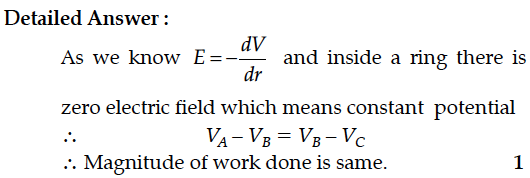In the given figure, charge +Q is placed at the centre of a dotted circle. Work done in taking another charge +q from A to B is W₁ and from B to C is W₂. Which one of the following is correct ?
i) W₁ > W₂
(ii) W₁ = W₂
(iii) W₁ < W₂

i) W₁ > W₂
(ii) W₁ = W₂
(iii) W₁ < W₂

(ii) As – = – magnitude of work done is same.


What is the amount of work done in moving a point charge around a circular arc of radius r at the center where another point charge is located ?
Derive an expression for potential due to a dipole for distances large compared to the size of the dipole. How is the potential due to dipole different from that due to single charge ?
An electric charge of 425 f μC is removed from a fully charged capacitor of capacitance 8.5μF. Its potential will be lowered by:
(a) 75 V
(b) 100 V
(c) 85 V
(d) 50 V
A point charge +Q is placed at point O as shown in the figure. Is the potential difference – positive, negative or zero ?
If 100 J of work has to be done in moving an electric charge of 4 C from a place, where potential is -10 volt to another place where potential is V volt,find the value of V.
(a) 5 V
(b) 10 V
(c) 25 V
(d) 15 V
Four point charges Q, q, Q and q are placed at the corners of a square of side ‘a’ as shown in the figure.
Equipotential surfaces at a great distance from a collection of charges whose total sum is not zero are approximately
(a) spheres
(b) planes
(c) paraboloids
(d) ellipsoids
How does the random motion of free electrons in a conductor get affected when a potential difference is applied across its ends ?
Define the term mobility of charge carriers in a conductor. Write its S.I. unit.
Why should electrostatic field be zero inside a conductor ?
A point charge +Q is placed at point O as shown in the figure. Is the potential difference – positive, negative or zero ?
Two point charges ‘q1’ and ‘q2’ are placed at a distance ‘d’ apart as shown in the figure. The electric field intensity is zero at a point ‘P’ on the line joining them as shown. Write two conclusions that you can draw from this.
Why do the electric field lines never cross each other ?
